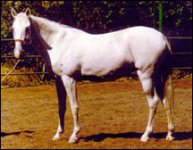♘امیرحسین♞
♘ مدیریت انجمن اسب ایران ♞
According to the map in Johannes Kalter's Arts and Crafts of Turkestan, the Yamoud tribes occupied an area north of that occupied by the Akhal-Teke, between the northern Caspian Sea and the Aral.
Many Yamoudi live today in Iran, as the area where they used to live is now salt desert and offers no grazing.
There are at least two substrains of Yamoud, the Yemreli and the Getman.
The photo at left (above) shows an aged grey Yamoud mare bred in Iran. Note that she has a stockier body than the Tekke or Akhal-Teke. She has particularly powerful hindquarters and an excellent slope to powerful shoulders. The power in the hindquarters is especially evident in the mare at right. Note the extreme angle of the line between the point of the hip and the point of the buttock, and the development of the muscles of the rump. Both these mares show depth of girth and a strong, well-muscled loin. Note also, on the chestnut mare especially, that the legs have more bone and somewhat less dryness than one finds with the Tekke or Akhal-Teke. It should be pointed out, though, that as these different strains of Turkoman (Yamoud and Tekke) are often crossed by their Turkmen breeders (to keep strain-type from becoming too pronounced), it is often difficult to see differences in the various strains and especially in the substrains.
Many Yamoudi live today in Iran, as the area where they used to live is now salt desert and offers no grazing.
There are at least two substrains of Yamoud, the Yemreli and the Getman.
The photo at left (above) shows an aged grey Yamoud mare bred in Iran. Note that she has a stockier body than the Tekke or Akhal-Teke. She has particularly powerful hindquarters and an excellent slope to powerful shoulders. The power in the hindquarters is especially evident in the mare at right. Note the extreme angle of the line between the point of the hip and the point of the buttock, and the development of the muscles of the rump. Both these mares show depth of girth and a strong, well-muscled loin. Note also, on the chestnut mare especially, that the legs have more bone and somewhat less dryness than one finds with the Tekke or Akhal-Teke. It should be pointed out, though, that as these different strains of Turkoman (Yamoud and Tekke) are often crossed by their Turkmen breeders (to keep strain-type from becoming too pronounced), it is often difficult to see differences in the various strains and especially in the substrains.

